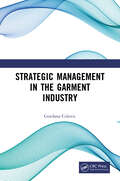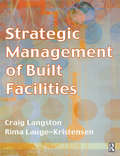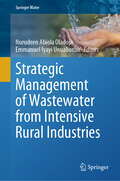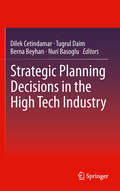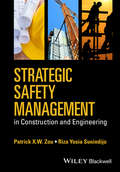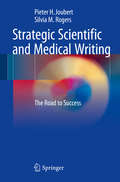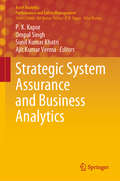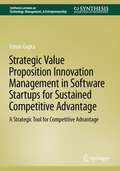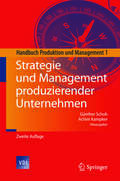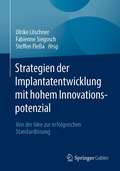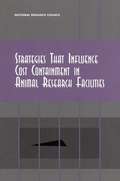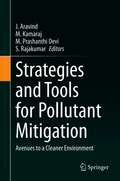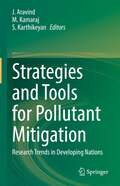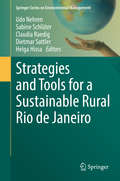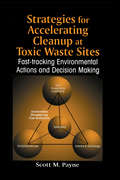- Table View
- List View
Strategic Management in the Garment Industry (Woodhead Publishing India Ser.)
by Gordana ColovicFrom supply chain finesse to market triumph, this book covers the advancements in business strategy and presents a multidisciplinary approach to strategic management in the garment industry. The subject matter of this book discusses – Strategic management Strategic marketing in garment industry Strategic methods Organizational behaviour Print edition not for sale in South Asia (India, Sri Lanka, Nepal, Bangladesh, Pakistan and Bhutan)
Strategic Management of Built Facilities
by Craig Langston Rima Lauge-KristensenThe effective management of facilities can significantly improve business productivity. In this textbook the authors provide an overview of facility economics and outline the way in which businesses and facility managers can get better value from their physical assets.Students on facilities management and property related degrees will find this an invaluable introduction.
Strategic Management of Innovation and Design
by Pascal Le Masson Benoît Weil Armand Hatchuel Pascal Le Masson Benoît WeilThere is now widespread agreement that innovation holds the key to future economic and social prosperity in developed countries. Experts studying contemporary capitalism also agree that the battle against unemployment and relocations can only be won through innovation. But what kind of innovation is required and what is the best way to manage, steer and organize it? Grounded on experiences of innovative firms and based on the most recent design theories, this book argues that instead of relying on traditional R&D and project management techniques, the strategic management of innovation must be based on innovative design activities. It analyses and explains new management principles and techniques that deal with these activities, including innovation fields, lineages, C-K (Concept-Knowledge) diagrams and design spaces. The book is ideal for advanced courses in innovation management in industrial design schools, business schools, engineering schools, as well as managers looking to improve their practice.
Strategic Management of Technological Learning (Technology Management Series)
by Elias CarayannisHow do companies such as BMW, Airbus Industrie, and Bayer leverage technology and learn to thrive where others fail? This book provides a one-stop resource on technology, innovation, and knowledge management. It gives you a tool for gaining short-term, case-specific insight and long-term, industry-wide understanding of the best technology management and learning policies and practices. The Strategic Management of Technological Learning explores a portfolio of case studies on technology-driven-but not exclusively high-tech-companies that have an overall long-term record of success and prosperity.Through in-depth interviews with industry practitioners, the author empirically identifies the presence of Strategic or Active Incrementalism. The following chart shows the studied firms, which operate at high risk and uncertainty, very dynamic, and technologically intensive business environments:
Strategic Management of Wastewater from Intensive Rural Industries (Springer Water)
by Nurudeen Abiola Oladoja Emmanuel Iyayi UnuabonahThis book provides insight into the environmental and ecological impacts of the operations of intensive rural industries and how these undesirable impacts can be effectively managed. In the developing economies, the different human empowerment and poverty alleviation schemes have produced myriads of intensive rural industries that littered States in these economies. These industries are often characterized by their small scale, outmoded technology, obsolete equipment, poor management and large water consumption. Since their operations usually consume large volume of fresh water, high magnitude of untreated wastewater is equally discharged. The huge consumption of freshwater puts a lot of stress on freshwater resource available for human use, and the discharge of contaminated wastewater from these industries disrupts the ecological balance. It has been reported that untreated industrial waste constitutes about two-thirds of the total waste discharge into water bodies, and the largest chunk of this is derived from rural enterprises. Therefore, the environmental cost of rural industrialization is enormous and needs to be examined.The evaluation of the quality characteristics, the socioeconomic impacts and the law guiding the generation and the discharge of the wastewater from specific rural industries are enunciated. The conventional practice and the trends in the effective management of specific wastewater samples are also discussed.
Strategic Planning Decisions in the High Tech Industry
by Berna Beyhan Dilek Cetindamar Tugrul Daim Nuri BasogluThe scale and complexity of research and practices of open innovation mandate a correspondingly sophisticated form of decision making. Strategic Planning Decisions brings together a number of tools that ease the decision process in technology companies, providing both conceptual frameworks and practical applications. Innovative approaches are presented such as an ontology-based model where all the relevant aspects of a potential technology are interrelated to provide a comprehensive and logically connected data pool for decision makers. Divided into two sections, Strategic Planning Decisions describe both strategic approaches using the decision tools, and tactical approaches. Some of these tools are expanded while some others are embedded in a model that will lay the ground for practical application. These include: bibliometric analysis, ontology, roadmapping, lead user, six sigma, and multi-actor & multi-objective decision making methods Recent research and relevant theory are balanced with up-to-date practical applications and hands-on techniques making Strategic Planning Decisions ideal for engineers who wish to keep up-to-date with current ideas in the field of TM. It also provides workable methods for practising managers from all levels who wish to apply a more rigorous approach in their work and consultants concerned with technology assessment and its management.
Strategic Planning Models for Reverse and Closed-Loop Supply Chains
by Kishore K. Pochampally Surendra M. Gupta Satish NukalaThe rapid technological development of new products, coupled with the growing consumer desire for the latest technology, has led to a new environmental problem: products that are discarded prematurely. But behind every problem lies an opportunity. Many of these products can be reprocessed, leading to savings in natural resources, energy, landfill s
Strategic Planning for Urban Transportation: A Dynamic Performance Management Approach (System Dynamics for Performance Management & Governance #3)
by Guido NotoThis book focuses on the adoption of a Dynamic Performance Management (DPM) approach to support the planning and management of urban transportation systems. DPM allows one to embrace a dynamic and systemic perspective and, as a result, to frame the contribution of different stakeholders, in terms of outcome-based performance, at an inter-institutional level. The discussed DPM approach allows one to focus on the causal relationships and feedback processes that characterize urban transportation systems’ governance. Particularly, through the adoption of such an approach, it is possible to identify outcome-based performance measures that help to monitor and drive the governance network toward the creation of public value for the reference communities.Strategic Planning for Urban Transportation: A Dynamic Performance Management Approach begins with an examination of urban transportation, highlighting the main criticalities and future challenges of managing it. Next, the book examines the governance of urban transportation including how to identify and engage stakeholders. Finally, the book introduces the main application of DPM and system dynamics to urban areas, with specific regards to transportation. The framework is outlined, and a case study is provided as a practical example of how to apply the model. This book should be useful to urban transportation decision-makers at both the managerial and political level.
Strategic Planning for the Florida Citrus Industry: Addressing Citrus Greening Disease
by National Research Council of the National AcademiesCitrus greening, a disease that reduces yield, compromises the flavor, color, and size of citrus fruit and eventually kills the citrus tree, is now present in all 34 Floridian citrus-producing counties. Caused by an insect-spread bacterial infection, the disease reduced citrus production in 2008 by several percent and continues to spread, threatening the existence of Florida's $9.3 billion citrus industry. A successful citrus greening response will focus on earlier detection of diseased trees, so that these sources of new infections can be removed more quickly, and on new methods to control the insects that carry the bacteria. In the longerterm, technologies such as genomics could be used to develop new citrus strains that are resistant to both the bacteria and the insect.
Strategic Safety Management in Construction and Engineering
by Patrick Zou Riza Yosia SunindijoAlthough the construction and engineering sector makes important contributions to the economic, social, and environmental objectives of a nation, it has a notorious reputation for being an unsafe industry in which to work. Despite the fact that safety performance in the industry has improved, injuries and fatalities still occur frequently. To address this, the industry needs to evolve further by integrating safety into all decision making processes. Strategic Safety Management in Construction and Engineering takes a broad view of safety from a strategic decision making and management perspective with a particular focus on the need to balance and integrate 'science' and 'art' when implementing safety management. The principles covered here include the economics of safety, safety climate and culture, skills for safety, safety training and learning, safety in design, risk management, building information modelling, and safety research methods and the research-practice nexus. They are integrated into a strategic safety management framework which comprises strategy development, implementation, and evaluation. Practical techniques are included to apply the principles in the context of the construction and engineering industry and projects. Case studies are also provided to demonstrate the localised context and applications of the principles and techniques in practice.
Strategic Scientific and Medical Writing
by Silvia M. Rogers Pieter H. JoubertA document may be based on accurate medical and scientific information, follow guidelines precisely, and be well written in clear and correct language, but may still fail to achieve its objectives. The strategic approach described in this book will help you to turn good medical and scientific writing into successful writing. It describes clearly and concisely how to identify the target audience and the desired outcome, and how to construct key messages for a wide spectrum of documents. Irrespective of your level of expertise and your seniority in the pharmaceutical, regulatory, or academic environment, this book is an essential addition to your supporting library. The authors share with you many years of combined experience in the pharmaceutical and academic environment and in the writing of successful outcome-driven documents.
Strategic Supply Chain Management (EAI/Springer Innovations in Communication and Computing)
by Zhang Yu Syed Abdul KhanThis book covers the scope of supply chain and logistics, which has continued to grow with a rapid speed. The book includes core aspects of supply chain and logistics philosophy and practice. The authors then cover the general principles of supply chain and logistics that can be applied in countries throughout the world. Where concepts cannot be generalized, they are based primarily on a European model. The authors have also added some international material and examples from China, Pakistan, India, and the USA. The book is intended to help in the quest of supply chain and logistics to reduce cost and improve service, as well as to keep up-to-date the different facets of supply chain and logistics in a global market. In addition, this book helps candidates to who are undertaking examinations for universities and professional institutes, and bachelor and master students who are studying for degrees in supply chain management. In addition, the book covers technical terminologies, definitions, and a supply chain dictionary.
Strategic System Assurance and Business Analytics (Asset Analytics)
by Ajit Kumar Verma P. K. Kapur Ompal Singh Sunil Kumar KhatriThis book systematically examines and quantifies industrial problems by assessing the complexity and safety of large systems. It includes chapters on system performance management, software reliability assessment, testing, quality management, analysis using soft computing techniques, management analytics, and business analytics, with a clear focus on exploring real-world business issues. Through contributions from researchers working in the area of performance, management, and business analytics, it explores the development of new methods and approaches to improve business by gaining knowledge from bulk data. With system performance analytics, companies are now able to drive performance and provide actionable insights for each level and for every role using key indicators, generate mobile-enabled scorecards, time series-based analysis using charts, and dashboards.In the current dynamic environment, a viable tool known as multi-criteria decision analysis (MCDA) is increasingly being adopted to deal with complex business decisions. MCDA is an important decision support tool for analyzing goals and providing optimal solutions and alternatives. It comprises several distinct techniques, which are implemented by specialized decision-making packages. This book addresses a number of important MCDA methods, such as DEMATEL, TOPSIS, AHP, MAUT, and Intuitionistic Fuzzy MCDM, which make it possible to derive maximum utility in the area of analytics. As such, it is a valuable resource for researchers and academicians, as well as practitioners and business experts.
Strategic Value Proposition Innovation Management in Software Startups for Sustained Competitive Advantage: A Strategic Tool for Competitive Advantage (Synthesis Lectures on Technology, Management, & Entrepreneurship)
by Varun GuptaThis book aims to increase the success rates of startups by focusing on value proposition innovation, which is propelled by the involvement of potential consumers as well as other resources such as freelancers and strategic relationships with academia. The author shows how startups who are resource constrained can invest efforts exploring the potential market of their products. The author also explores how global markets can be beneficial for a startup’s success, while showing the workarounds in hard-to-access markets. The book investigates gaining knowledge shared by freelancers, customers, and academia, whose involvement can be crucial in supporting value proposition innovation activities such as ideas generation, implementation, and commercialization. Combined, the author leads readers to discover their ability to foster value proposition innovations that result into long term competitive advantage in a highly fluctuating business environment.
Strategic and Sustainable Management of Workplace Facilities
by Yewande Adewunmi-AbolarinwaThis book introduces the reader to contemporary issues in the management of facilities in the African context and includes case studies from across the continent and internationally. It consolidates theory and practical information useful for managers and researchers across Africa and other developing countries. It covers a cross section of the key elements of facilities management, including customer relations management, emergency preparedness, development of a facilities strategy, sustainable buildings management, and management of intelligent buildings in developing countries.The book has been developed from a combination of degree level and professional course materials and academic resources and is therefore suitable for use by students on undergraduate and postgraduate degree programmes, professional short courses, and for practicing facilities managers and members of IFMA, SAFMA, IWFM, HEFMA, RICS, Association of Facilities Management Practitioners of Nigeria, Egypt Facility Management Association, Botswana Facilities Management Association, and the Africa Facilities Management Association as a key reference. This book is key reading for anyone: Studying for a degree in Facilities Management, Real Estate, Estate Management, Workplace Management, or Surveying Wanting to be more strategic in their facilities management and operations Transitioning into a facilities management role from another profession Benchmarking and analysing the performance of their built assets Training themselves or their staff in emerging areas such as workplace productivity, sustainability, and intelligent buildings systems Interested in researching emerging areas of facilities management in developing countries This is the essential guide to the growing field of facilities management in some of the world’s fastest developing countries.
Strategie per la gestione del tempo – Come riavere indietro il tuo tempo
by Consalvo Cattuto Tony GrayImmagina cosa potresti fare della tua vita una volta padroneggiata la disciplina della gestione del tempo. Impara come gestire il tuo tempo in modo efficace e potenzia le tue liste di cose da fare in tempo record. Questa guida completa ti aiuterà rapidamente a controllare il tuo tempo invece di permettere al tuo tempo di controllare te. Dentro troverai ... * Come assegnare le priorità alla tua lista di cose da fare * Come far funzionare la legge 80/20 nella tua vita * Come tamponare le perdite di tempo * Perché il multi-tasking ti rallenterà * Come farsi delle aspettative realistiche * Ed altro! Le strategie per gestione del tempo sono utili a studenti, insegnanti, infermieri e altri ancora ...
Strategie und Management produzierender Unternehmen
by Günther Schuh Achim KampkerProduzierende Unternehmen stehen heute in einem Spannungsfeld, das von unterschiedlichen Anspruchsgruppen und einer hohen wirtschaftlichen Dynamik geprägt ist. Daher ist es wichtig, Entscheidungen unter Berücksichtigung aller relevanten Aspekte schnell und sicher zu treffen. Das Nachschlagewerk bietet einen Überblick über relevante Ansätze und damit die Grundlage, um daraus abgeleitete Methoden anzuwenden. Führungskräfte bekommen ein Instrumentarium an die Hand, das es ihnen ermöglicht, ihre Organisationseinheit effektiv und effizient zu steuern.
Strategien der Implantatentwicklung mit hohem Innovationspotenzial: Von der Idee zur erfolgreichen Standardlösung
by Steffen Fleßa Ulrike Löschner Fabienne SiegoschEine hervorragende Technologie garantiert noch nicht, dass sie sich als Standard durchsetzt. Die Entwicklung innovativer Implantate bildet einen hochkomplexen Prozess, der insbesondere aufgrund seines hohen finanziellen Risikos und seiner zahlreichen Barrieren von Beginn an ein systematisches Management erfordert. Dieses Buch präsentiert eine übersichtliche Zusammenfassung des Implantatentwicklungsprozesses von der initialen Produktidee bis zur Standardlösung einschließlich der wichtigsten Elemente, Barrieren und Strategien. Ein besonderer Fokus liegt dabei auf der Zusammenführung ökonomischer, demografischer und medizinischer Perspektiven. Es bietet eine Art Handlungsleitfaden und dient daher als praxisorientierte Unterstützung für Ökonomen, Mediziner und Ingenieure aus den Bereichen Forschung und Implantatentwicklung.
Strategies That Influence Cost Containment in Animal Research Facilities
by National Research CouncilA report on Strategies That Influence Cost Containment In Animal Research Facilities
Strategies and Communications for Innovations: An Integrative Management View for Companies and Networks
by Michael Hülsmann Nicole PfeffermannThe innovation economy sets new standards for global business and requires efficient innovation management to plan, execute and evaluate innovation activities, establish innovative capability and coordinate resources and capacities for innovation on an intra- and inter-organizational level. Moreover, communication of innovation is one essential impact factor of innovation success due to successful launches of innovations into markets, establishment of stakeholder relationships, and strengthened corporate reputation in the long-run. Consequently, the portfolio of communication activities for innovations has to be mastered by a company or collaborative network equal to the innovation portfolio. Thus, management of innovation and innovation communication on a strategic level play an important role in business nowadays. This new book concentrates on new approaches and methods for strategies and communications for innovations. As one part of the book, integrated perspectives on strategy and communication for innovation intend to bridge the gap between innovation management and communication management. This new book shall contribute to management science and answer current question in business. It provides cutting-edge information and offers a knowledge source for researchers, students, and business representatives who design, implement and manage innovation and innovation communication / marketing of innovation.
Strategies and Tools for Pollutant Mitigation: Avenues to a Cleaner Environment
by J. Aravind M. Kamaraj M. Prashanthi Devi S. RajakumarThis volume explores recent research trends and achievements in environmental pollution remediation (e.g. water, air, soil), and compiles critical and constructive papers and reviews with a focus on advances in bioremediation and green technology solutions for waste minimization, waste management and pollution control. The book is timely, as the need for researchers and engineers to develop sustainable and green eco-friendly remediation technologies is increasing with a growing global population, stressed agricultural systems, and an environment impacted by climate change. A key focus of the book is on the efficient use of agricultural waste residues as viable substrates for creating materials for environmental clean-up, and the possible conversion of these pollutants to sustainable bioresources. The volume will be of interest to sustainability researchers, environmental engineers, industry managers and agricultural scientists.
Strategies and Tools for Pollutant Mitigation: Research Trends in Developing Nations
by J. Aravind M. Kamaraj S. KarthikeyanThis book offers an overview of the latest work in environmental remediation and waste management coming out of developing nations. It is split into two sections: one on state-of-the-art sustainable remediation approaches, and the other covering waste management for a cleaner environment The ten chapters in this book are structured as reviews that assimilate recent works in these areas; they provide a centralized resource for scholars in developing nations who are working in environmental remediation and waste management. The volume will be of interest to sustainability researchers, environmental engineers, industry managers and agricultural scientists.
Strategies and Tools for a Sustainable Rural Rio de Janeiro (Springer Series On Environmental Management Ser.)
by Udo Nehren Sabine Schlϋter Claudia Raedig Dietmar Sattler Helga HissaThis book is a compilation of recent developments in land, ecosystem, and water management in the Brazilian state of Rio de Janeiro. The state is located in the biodiversity hotspot of the Atlantic Forest (Mata Atlântica), a biome characterized by high biological diversity and endemism. At the same time the state of Rio de Janeiro emerged to one of the economic hubs in Latin America. This development process has been accompanied by population growth, industrialization, urbanization, as well as consumption and degradation of land and water resources. In the past years many efforts have been made to stop or at least slow down these degradation processes and restore degraded environments with the overall goal to bring together sustainable management of natural resources, nature conservation, and economic development. An overview is provided of the different strategies and tools that have been developed in the fields of agriculture, ecosystem management and biodiversity, integrated water management, land restoration, disaster risk reduction and climate change adaptation, as well as environmental governance and economic instruments. This book covers a wide spectrum from applied research to science‐policy interfaces, planning concepts, and technical tools and has a model character for other rural areas in Latin America. Target groups are scientists, practitioners, policy makers and graduate students in the field of environmental management. The different chapters are written by researchers and practitioners of the German‐Brazilian project INTECRAL (Integrated Eco Technologies and Services for a Sustainable Rural Rio de Janeiro), the rural development program Rio Rural under the state secretary for agriculture and animal husbandry, as well as invited scientists from Brazilian universities and research institutes. It bridges existing gaps between science, policies, and practice in rural development.
Strategies and Trends in Organizational and Project Management (Lecture Notes in Networks and Systems #380)
by Pavel V. Trifonov Marina V. CharaevaThis book includes the papers presented at the II International Applied Research Conference “Operations and Project Management: Strategies and Trends” and the International Research Conference “Management in Financial Economy” held in Rostov-on-Don on May 19–20, 2021 within the framework of the South Russia Business Education Forum. The articles included in the book present a comprehensive analysis of the problems of adaptation of traditional and new methods of operational and project management, development of technologies for business process and supply chain management, development trends in financial economy discussed both on a global scale and in the context of sustainable socio-economic development at the meso-level of regions and industries, which not only reveals the nature of the ongoing processes, but also demonstrates their specifics in industry, agriculture, service industry in Russia, CIS countries, Europe, and China. Particular attention is paid to business education in the new economic realities. The polemical focus of the above-mentioned issues in conjunction with the accuracy of the presented analytics makes it possible to come to unconventional, though practically realizable solutions.
Strategies for Accelerating Cleanup at Toxic Waste Sites: Fast-Tracking Environmental Actions and Decision Making
by Scott Marshall PayneAccelerating Cleanup at Toxic Waste Sites: Fast-tracking Environmental Actions and Decision Making presents truly innovative advances in investigative and cleanup technologies, offering valuable solutions that streamline the data collection process, speed up the time it takes to characterize a site, and expedite decision making.Using easy to understand graphic displays, tables, text summaries, and real world case studies, and by synthesizing technical and regulatory reference information crucial to the development of effective cleanup strategies, this book provides the framework for environmental professionals to develop project and program approaches that meet today's needs.An advanced text for those with at least basic understanding of environmental investigation, cleanup, regulations, decision making, and policy development, Accelerating Cleanup at Toxic Waste Sites addresses the "human" side of the environmental industry and why it is perhaps one of the most important considerations for successful accelerated cleanup. This book takes the next step by providing managers, project teams, and other professionals with approaches that bring techniques, regulations, strategies, and people together into one comprehensive package that works.
